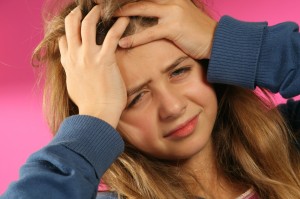Last Update December 18, 2014

philippe Devanne/Dollar Photo Club
Headaches are bad enough, but when they occur in children it can be heartwrenching. The good news is headaches in teenagers and kids can be managed very well.
First things first. It should NEVER be acceptable for a child to have headaches and manage them with medications. Period. It’s bad enough to accept headaches in adults when have had a lifetime of abuse on their bodies and brains. But when they happen in a child something is wrong and whatever it is needs to be identified and eliminated.
Merely medicating the problem is a very bad idea. Using chronic medication to prevent headaches in children should be heavily frowned upon.
The causes are many and varied. They can include:
- Structural problems related to carrying a heavy backpack or sports. Get to a chiropractor.
- Vision problems. Get to an optician.
- Stress / family issues. Resolve them for your child’s sake. Get to a therapist.
- Anemia
- Poor quality diet
- Artificial sweeteners
- Allergies
The list can get quite long, but if you’ve got the time, read through past posts related to migraines here.
This particular article focuses on a powerful tool that can help greatly with headaches in teenagers as well as headaches in children.
Biofeedback. Biofeedback, in general, is a process by which a device is used help the user gain greater control over some type of biological function such as blood pressure, breathing or skin temperature. The Resperate is a biofeedback device for breathing that is FDA approved to lower blood pressure that we use with very good results in our office.
Researchers looked at biofeedback in pediatric headaches to see if biofeedback was effective and, if so, what factors influenced its effectiveness. Findings are summarized as follows:
- Headache frequency dropped from 3.5 to 2 headache days (keep in mind that Topamax was 1/3 less effective than this!)
- The response rate was 58% overall; 48% for chronic headaches and 73% for episodic headaches
- The ability to raise hand temperature by >3 degrees and use of selective serotonin reuptake inhibitors (SSRIs) were associated with a positive response
- Preventive medication (think Elavil, Tegretol, Depakote, Inderal) use actually kept the biofeedback from working
(Personally, I don’t like the finding that SSRIs were associated with a positive response, but it is what it is…)
So, if your child is experiencing headaches, biofeedback is just yet another tool that can help to calm the brain and settle activity down. There are even multiple apps available on the Droid and iPhone that you can download and have on hand as an immediate tool.
If your child has or is experiencing headaches, we prophylactic medications recommended before lifestyle changes?
